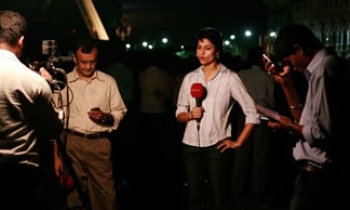WASHINGTON - The red camera light blinked on, and news anchor Jennifer Gray began speaking: "In Iraq ..."
Her face and words flashed via satellite from an Alexandria studio around the world.
But, Gray isn't a TV reporter on NBC, CNN or FOX.
She's a Navy petty officer who anchors a news show on the Pentagon Channel.
Gray and her colleagues report to audiences as close as the barracks at Quantico Marine Corps base and as distant as the forward operating base in Fallujah, Iraq.
She is part of a globe-spanning Pentagon news operation, the American Forces Information Service, that sends news about the Defense Department to troops, dependents and, increasingly, to the general public.
The TV channel alone has a potential civilian audience through satellite and local cable stations of more than 12 million U.S. households.
Some critics say the Pentagon is spreading propaganda, not news, with the taxpayer-paid service.
"It really does blur the line between propaganda and news when you have any government agency, but especially the military, producing news that's intended for the general population," said Sheldon Rampton, research director of the media watchdog Center for Media and Democracy, based in Madison, Wis.
Pentagon officials disagree, saying their TV, radio and Internet news products are meant for an internal audience. Viewers have a visual clue that it's not commercial TV news: All the on-air journalists wear military uniforms.
Alison Barber, deputy assistant secretary of defense for internal communications and public liaison, oversees the information service.
Media researchers aren't so sure.
"When they say it's not intended for domestic consumption, you have to take it with a grain of salt," Rampton said.
The Pentagon, like the White House, clearly wants to influence the public's view of the military and the war on terrorism, he added.
The Pentagon Channel, with 72 staff members, operates 24-7. It produces a daily, 30-minute news show and hourly news updates. The channel also broadcasts Pentagon news conferences live, congressional hearings, documentaries and other military information.
The channel, which started May 14, 2004, can be watched on 310 military bases, local cable systems and satellite and the Web, where the service is streamed live.
AFIS also operates the American Forces Press Service, which distributes print stories written by Pentagon-employed journalists, and DefenseLINK and other Web sites run by the military.
With seven correspondents in Washington and hundreds of military public affairs personnel available to write articles, the press service sends out a dozen or more print stories every weekday. Most articles go into base newspapers, and all go on the Pentagon's DefenseLINK Web site. Other staffers work on content and design for the DefenseLINK, War on Terror and America Supports You Web sites.
The Pentagon-written stories are popular with some bloggers who repost the stories or cite them while bashing mainstream media coverage of the war.
The information service also oversees a TV and radio service separate from the Pentagon Channel that transmits U.S. entertainment, sports and news programs to overseas bases; the Stars & Stripes newspaper and the military's public affairs school. Its total budget is about $150 million a year with the TV news channel and press service costing about $7 million a year together.
An author of a book about government propaganda, Utah State journalism professor Mike Sweeney, said the Pentagon information service is analogous to the communications department at a large corporation.
"The difference with corporate public relations is that our tax dollars are funding it," he added. "If we're using tax dollars to promote a political slant, that's wrong."
Barber and other AFIS officials denied any political agenda but acknowledged the information service has a pro-military slant.
Working as a TV or press service reporter for the Pentagon isn't too different from civilian stations or newspapers, say Pentagon journalists.
"There are more similarities than differences," said Jim Garamone, a civilian who's a 20-year veteran of the press service. "We scramble for stories just like the other reporters."









